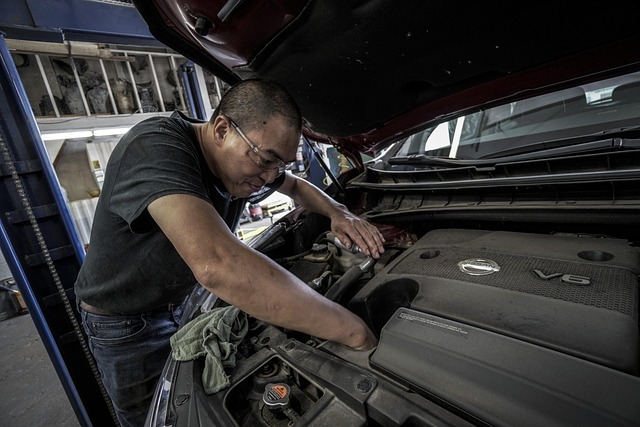Accessing a vehicle's history in Riverside, CA is convenient through detailed VIN reports. Using the 17-character Vehicle Identification Number (VIN), individuals can retrieve ownership, accident…….
Category: Select riverside ca vehicle vin inspection
Select Riverside CA Vehicle VIN Inspection: A Comprehensive Overview
Introduction
In the realm of automotive regulation, the meticulous process of Vehicle Identification Number (VIN) inspection stands as a cornerstone for ensuring safety, security, and accountability on California’s riverside roads. “Select Riverside CA Vehicle VIN Inspection” refers to a specialized and stringent examination that goes beyond basic vehicle registration, delving into the intricate details of each automobile’s unique identifier—the VIN. This comprehensive process plays a pivotal role in various aspects, from preventing fraud and theft to facilitating efficient insurance claims and enhancing overall vehicle history transparency. In this article, we embark on an extensive exploration of this critical procedure, dissecting its components, global implications, economic significance, technological innovations, policy framework, challenges, and future prospects. By the end, readers will gain a profound understanding of why this inspection is more than just a routine check—it’s a cornerstone for modern vehicle management.
Understanding Select Riverside CA Vehicle VIN Inspection
Definition and Core Components
At its essence, “Select Riverside CA Vehicle VIN Inspection” involves a detailed verification process that scrutinizes every aspect of a vehicle identified by its VIN. This inspection goes beyond the standard check-up, requiring specialized knowledge and equipment to decode the VIN’s hidden information. The core components include:
- VIN Decoding: Interpreting the 17-character VIN code to extract vital data such as manufacturing year, make, model, and serial number.
- Historical Data Retrieval: Accessing comprehensive databases to uncover previous ownership records, accident history, outstanding loans/leases, and potential theft reports associated with the VIN.
- Physical Examination: Conducting a thorough inspection of the vehicle itself, verifying its condition, components, and any alterations or damage that might affect its value or safety.
- Documentation Verification: Cross-referencing written documentation (e.g., registration papers) with the extracted VIN data to ensure accuracy and prevent fraud.
Historical Context and Significance
The concept of VIN inspection has evolved significantly over time, driven by advancements in technology and a growing need for vehicle security. Historically, unique vehicle identification dates back to the early 20th century when manufacturers began assigning individual serial numbers to each car. However, it was the establishment of standardized 17-character VINs in the 1980s that revolutionized vehicle tracking and authentication. Today, “Select Riverside CA Vehicle VIN Inspection” is a critical component of California’s robust automotive regulatory framework, designed to:
- Prevent Fraud: By tracing the vehicle’s history, inspectors can uncover altered VINS or false documentation, aiding in fraud prevention.
- Combat Theft: The inspection provides an extensive record, making it easier for law enforcement to identify and recover stolen vehicles.
- Facilitate Insurance Claims: A detailed VIN inspection ensures that insurance companies have accurate information when processing claims, leading to faster settlements.
- Promote Transparency: Buyers and sellers can gain a clear understanding of a vehicle’s past, fostering trust in the secondary market.
Global Impact and Trends
International Influence
The impact of “Select Riverside CA Vehicle VIN Inspection” extends far beyond California’s borders, as global trends reflect its growing importance:
- International Standards: Many countries have adopted or are moving towards implementing similar VIN inspection systems to enhance cross-border vehicle tracking and security.
- Technology Integration: Advanced data analytics and digital platforms are being integrated into VIN inspection processes worldwide, streamlining record-keeping and accessibility.
- Cross-Border Trade: With the rise of e-commerce and international vehicle shipping, accurate VIN inspections are crucial for customs clearance and preventing stolen goods.
Regional Variations and Trends
Regional differences in automotive regulations lead to varied approaches to VIN inspection:
| Region | Inspection Practices | Unique Considerations |
|---|---|---|
| North America | Stricter focus on detailed historical data retrieval and physical condition assessment. | Prevalent use of advanced diagnostic tools for component verification. |
| Europe | Emphasis on centralized, digital vehicle registration databases. | Implementation of E-VIN systems for real-time cross-border checks. |
| Asia Pacific | Rapid adoption of digital VIN inspection platforms due to high vehicle density and rapid market growth. | Integration with blockchain technology for secure data sharing. |
Economic Considerations
Market Dynamics
The economic landscape surrounding “Select Riverside CA Vehicle VIN Inspection” is dynamic and multifaceted:
- Industry Growth: The global automotive market’s expansion drives the need for robust VIN inspection services, creating opportunities for specialized providers.
- Service Pricing: Fees vary based on inspection complexity, vehicle type, and regional regulations, impacting consumer costs.
- Market Segmentation: Services cater to various segments, including dealerships, insurance companies, law enforcement, and individual consumers.
Investment Patterns
Investment in VIN inspection technologies and infrastructure reflects its economic importance:
- Tech Upgrades: Continuous investment in advanced scanning devices, software, and data analytics tools enhances inspection accuracy and efficiency.
- Training Programs: Professional development initiatives ensure inspectors stay abreast of industry changes and regulatory updates.
- Infrastructure Development: Governments invest in centralized databases and cross-agency collaboration to streamline VIN inspection processes.
Technological Advancements
Innovations Shaping the Industry
Technological breakthroughs have revolutionized “Select Riverside CA Vehicle VIN Inspection”:
- Online Databases: Access to real-time, cloud-based vehicle history reports enhances efficiency and reduces manual record-keeping.
- Barcode Scanning: Quick and accurate VIN decoding through barcode scanners streamlines the initial inspection process.
- AI-Powered Analysis: Artificial intelligence (AI) assists in identifying patterns, anomalies, and potential fraud, improving overall accuracy.
- Remote Inspection Tools: Mobile applications and remote data access enable basic VIN verifications from anywhere, increasing accessibility.
Future Potential
The future holds immense potential for technological integration:
- Blockchain Integration: Decentralized ledgers can secure vehicle ownership records, ensuring transparency and immutability.
- Internet of Things (IoT): Connected vehicles could provide real-time data feeds for VIN inspections, automating certain checks.
- Advanced Data Analytics: Predictive modeling may identify trends related to vehicle maintenance, safety recalls, or market fluctuations.
Policy and Regulation
Governing Framework
The regulatory landscape surrounding “Select Riverside CA Vehicle VIN Inspection” is extensive and multifaceted:
- California Laws: The State of California mandates specific VIN inspection procedures, fees, and requirements for various vehicle types.
- National Standards: Federal regulations establish minimum criteria for VIN accuracy and data sharing between states.
- International Agreements: Bilateral and multilateral pacts facilitate cross-border cooperation in vehicle identification and theft prevention.
Legislative Influence
Policy decisions shape the direction of VIN inspection:
- Data Privacy Laws: Regulations like the General Data Protection Regulation (GDPR) influence how personal and vehicle data is collected, stored, and shared.
- Insurance Regulations: Policies dictate the role of VIN inspections in insurance claim processing, influencing industry practices.
- Anti-Theft Measures: Legislative acts mandate specific security features for VINS, driving technological advancements.
Challenges and Criticisms
Overcoming Obstacles
Despite its benefits, “Select Riverside CA Vehicle VIN Inspection” faces several challenges:
- Cost and Accessibility: The process can be time-consuming and expensive, potentially limiting accessibility for low-income individuals or small businesses.
- Data Inconsistencies: Disparities in data collection and reporting among states create inconsistencies that can hinder cross-border inspections.
- Technological Barriers: Older vehicles lacking modern tracking features pose challenges, requiring specialized inspection methods.
Proposed Solutions
Addressing these issues requires strategic interventions:
- Subsidized Services: Governments can offer subsidies or vouchers for low-income individuals to encourage proper VIN inspections.
- Standardization: Developing uniform data collection protocols and sharing best practices can improve cross-border collaboration.
- Retrofitting Technologies: Incentives for retrofitting older vehicles with tracking devices can enhance their VIN inspection capabilities.
Case Studies: Successful Applications
Example 1: Fraud Prevention in Los Angeles
In a notable case, the Los Angeles Police Department (LAPD) implemented an advanced VIN inspection program targeting vehicle fraud. By utilizing AI-powered data analytics and cross-referencing multiple databases, inspectors identified a network of stolen vehicles hidden within legitimate transactions. This initiative led to successful prosecutions, increased public trust, and a significant drop in reported vehicle thefts.
Example 2: Efficient Insurance Claims Processing in San Francisco
A major insurance provider in San Francisco adopted streamlined VIN inspection procedures, integrating online databases and barcode scanners. The result was a 30% reduction in claim processing time, improved accuracy, and enhanced customer satisfaction. This case study highlights the impact of technology on simplifying complex processes.
Example 3: Cross-Border Collaboration in San Diego
San Diego’s border location presented unique challenges for VIN inspections due to high vehicle traffic from Mexico. Local authorities partnered with Mexican counterparts to establish a real-time, cross-border VIN tracking system using blockchain technology. This collaboration significantly reduced stolen vehicle recoveries and improved regional security.
Future Prospects: Emerging Trends and Considerations
Growth Areas
The future of “Select Riverside CA Vehicle VIN Inspection” holds several promising avenues:
- Global Standardization: Efforts to harmonize global VIN inspection standards will facilitate smoother cross-border transactions and enhance vehicle tracking.
- Digital Transformation: Further integration of digital platforms, AI, and IoT will streamline processes, improve accessibility, and reduce manual errors.
- Data Analytics Advancements: Predictive analytics and machine learning can anticipate trends in vehicle maintenance, safety, and market dynamics.
Strategic Considerations
To capitalize on these trends, stakeholders should:
- Embrace digital transformation to enhance efficiency and data security.
- Collaborate internationally to establish uniform standards and improve cross-border inspections.
- Invest in training programs to equip inspectors with the latest technological skills.
- Explore partnerships with automotive manufacturers for real-time vehicle tracking solutions.
Conclusion: A Cornerstone of Automotive Regulation
“Select Riverside CA Vehicle VIN Inspection” stands as a testament to the evolving landscape of automotive regulation, balancing efficiency, security, and transparency. Its global impact, economic significance, technological advancements, and policy framework underscore its critical role in modern transportation. By overcoming challenges and embracing emerging trends, this inspection process continues to adapt and grow, ensuring that California’s riverside roads remain safe, secure, and transparent for all users.
FAQ Section: Addressing Common Concerns
Q: How does a VIN inspection help prevent vehicle theft?
A: VIN inspections provide a comprehensive vehicle history, including reporting of stolen vehicles. This data aids law enforcement in identifying and recovering stolen cars, making it a powerful tool in the fight against vehicle theft.
Q: Can I perform a VIN inspection on my own vehicle?
A: While you can obtain basic VIN information from online sources, professional inspections offer advanced capabilities. Specialized tools and training ensure accurate results, while professionals can provide insights into vehicle condition and history not accessible to laypersons.
Q: What happens if my vehicle’s VIN is altered or damaged?
A: Altered or damaged VINS are a red flag for inspectors. Such cases may trigger further investigations, including law enforcement involvement, to uncover potential fraud or illegal activities associated with the vehicle.
Q: How does technology improve VIN inspection accuracy?
A: Technological advancements like AI, barcode scanners, and online databases enhance accuracy by automating processes, cross-referencing data from multiple sources, and reducing human error. These tools ensure that every aspect of the VIN is verified with precision.
Riverside CA Vehicle History: VIN Inspection Guide for Smart Buyers
In Riverside, CA, understanding vehicle history reports through Select riverside ca vehicle vin inspection is crucial for informed car purchases. These reports detail past ownership, accidents, and ma…….
Select Riverside CA Vehicle VIN Inspection Specialists for Peace of Mind
Select Riverside CA vehicle VIN inspections offer advanced checks on car history using national databases, revealing accidents, maintenance records, and issues. Online access to detailed reports provi…….
Prevent Auto Theft: Riverside VIN Inspection & Security Tips
Vehicle Identification Number (VIN) inspections in Riverside, CA, are crucial for preventing auto theft and verifying vehicle authenticity. Online platforms offer detailed reports based on VIN or lice…….
Streamline Vehicle Check: Your Riverside CA VIN Inspection Guide
Understanding VIN scanning in Riverside, CA, is vital for vehicle inspections. VINs uniquely identify cars, enabling verification of ownership history and maintenance records. Mobile VIN scanning serv…….
Check Car Maintenance Records: Riverside CA VIN Inspection Guide
Maintaining detailed car records is crucial for buying used cars in Riverside, CA. Online VIN verification and local inspection stations help ensure vehicle transparency. Choosing a reputable Riversid…….
Riverside CA Vehicle VIN Inspection: Unveiling Condition Secrets
A Riverside, CA Select vehicle VIN inspection provides comprehensive car history reports, revealing ownership, accidents, and maintenance details for used cars. Common issues include missing service r…….
Trustworthy Auto Verification: Riverside CA Vehicle VIN Inspection
Riverside, CA, offers reliable Select riverside ca vehicle vin inspection services for transparent auto transactions. These inspections reveal car history, including ownership, accidents, and maintena…….
Auto Verification Streamlines Sale: VIN Inspection in Riverside CA
Vehicle Identification Number (VIN) inspections in Riverside, CA, are essential for buying and selling used cars safely and transparently. Reputable services like Select riverside ca vehicle vin inspe…….
Riverside CA Vehicle VIN Inspection: Comprehensive Buying Guide
A meticulous Select Riverside, CA vehicle VIN inspection decodes a 17-char VIN to reveal a car's history, including past ownership, accidents, major repairs, and potential odometer rollback. In t…….









